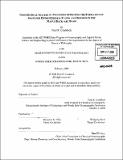Geochemical tracers of processes affecting the formation of seafloor hydrothermal fluids and deposits in the Manus back-arc basin
Author(s)
Craddock, Paul R
DownloadFull printable version (29.96Mb)
Other Contributors
Woods Hole Oceanographic Institution.
Advisor
Margaret K. Tivey and Wolfgang Bach.
Terms of use
Metadata
Show full item recordAbstract
Systematic differences in trace element compositions (rare earth element (REE), heavy metal, metalloid concentrations) of seafloor vent fluids and related deposits from hydrothermal systems in the Manus back-arc basin (Eastern Manus Basin, EMB and Manus Spreading Center, MSC) are used to investigate processes that affect their formation. Processes responsible for observed differences in fluids and deposits from distinct geologic settings include (a) fluid-rock interaction (with temperature, pressure and crustal composition as variables), (b) magmatic acid volatile input and, (c) local seawater entrainment and mixing with hydrothermal fluids, coupled with sulfide precipitation and metal remobilization. REE distributions in vent fluids in the Manus Basin exhibit a wide range of chondrite-normalized patterns that contrast with the relatively uniform distributions observed in mid-ocean ridge vent fluids. This heterogeneity is attributed to marked differences in fluid pH and fluoride and sulfate concentrations that significantly affect REE solubility. The data indicate that REEs can be used as indicators of the styles of magmatic acid volatile input in back-arc hydrothermal systems. Anhydrite in deposits record the same range of REE patterns, suggesting that REE distributions preserved in anhydrite can be used as indicators of past magmatic acid volatile input. Vent fluid heavy metal and metalloid concentrations also exhibit considerable differences. High metal concentrations in EMB versus MSC vent fluids reflect low pH, largely from input of magmatic acid volatiles (indicated by fluoride concentrations greater than seawater). In EMB, metal concentrations are locally affected by dissolution of previously deposited sulfide owing to low pH conditions affected by magmatic acid volatile input or seawater entrainment and mixing with hydrothermal fluid that leads to sulfide precipitation and secondary acidity generation. (cont.) Massive sulfide deposits in the Manus Basin exhibit a wide range of mineral compositions and heavy metal enrichments. The formation of Zn-rich (sphalerite/wurtzite) deposits in the MSC and of Cu-Fe and Cu-As-rich (chalcopyrite, tennantite) deposits in the EMB reflects differences in the conditions of sulfide precipitation (temperature, pH) and in metal concentrations. The data suggest that heavy metal and metalloid distributions in massive sulfide deposits can be used as indicators of the conditions of vent deposit formation.
Description
Thesis (Ph. D.)--Joint Program in Chemical Oceanography (Massachusetts Institute of Technology, Dept. of Earth, Atmospheric, and Planetary Sciences; and the Woods Hole Oceanographic Institution), 2009. Includes bibliographical references.
Date issued
2009Department
Joint Program in Chemical Oceanography; Woods Hole Oceanographic Institution; Massachusetts Institute of Technology. Department of Earth, Atmospheric, and Planetary SciencesPublisher
Massachusetts Institute of Technology
Keywords
Earth, Atmospheric, and Planetary Sciences., Joint Program in Chemical Oceanography., Woods Hole Oceanographic Institution.